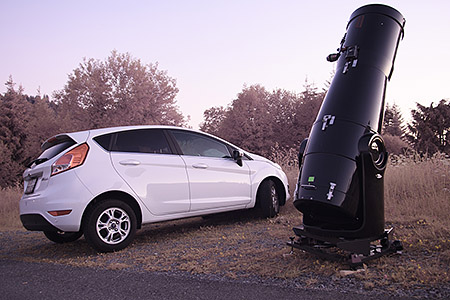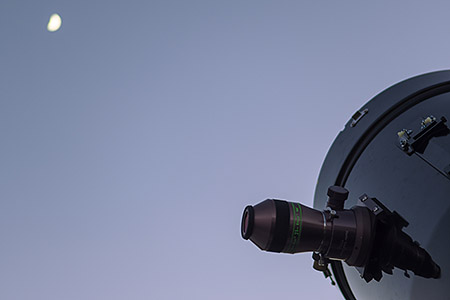Kasai Trading Ninja-400 16-inch f/4.5 dobsonian
In 2013, I purchased a second-hand 16-inch f/4.5 Newtonian telescope called "Ninja", a collapsible glass fiber reinforced plastic (GRP) dobsonian. It takes about one or two minutes to put together the five parts of the telescope structure. The "Ninja" combines the benefits of a truss tube and a solid tube: The telescope can be broken down into smaller and lighter pieces for storage, carrying, and transport. Assembled, the "solid" telescope tube has greater rigidity for holding collimation and attaching heavier accessories (Telrad and finder scope, heavy eyepieces, binocular viewer) than the common truss tube and it offers good protection against dew and stray light. The tube's interior has a rough texture painted in flat black. The tube goes well beyond the secondary mirror and contains a simple but effective baffling system.

I wasn't overly excited about the Ninja telescope when I first saw one between 1999 and 2000. My thoughts were something like "ok, so we now have a large garbage can at the observing site". The smell and the "cheap" look of GRP material were something to get used to for an expensive large-aperture telescope. And why, for God's sake, did they choose a mirror with an f/ratio of 4.5? Back then, I was an adherent of telescopes with a long focal length. And by long, I mean f/10 and thereabouts. Mr. Kasai himself flew from Japan to Switzerland to demonstrate the concept of a 16-inch Ninja at the Swiss Star Party in 2001. He assembled the telescope in one minute amid loud applause. I still wasn't impressed.
It wasn't until that wonderful night in 2009, when I was observing Jupiter with my 10-inch f/11 planetary Newtonian Ganymede and a borrowed 12-inch f/4.5 Ninja side by side. It took me almost 45 minutes to put together my well-established 10-inch reflector (weighing over 100 kilograms) and it got beaten by a telescope which was assembled in one minute. It was an awful experience. I'll never forget the pastel colors and details in Jupiter's atmosphere depicted by the 12-inch dobsonian (with a central obstruction of 25%).
The 10-inch reflector with its Zerodur mirror and a central obstruction of a mere 12% was "almost there", offered almost the same impressive image quality, but it got beaten. The structured main belts, the Great Red Spot, the dark and white ovals, the bluish swirls, the festoons and the barges at the edge of the main belts and in between were magnificent. All that could be seen in both telescopes, but the 12-inch Ninja clearly showed more vivid colors and bore a bit more magnification or offered a brighter, more pleasant image at the same magnification. Aperture always wins (if the optical quality is good) and if the telescope with the larger aperture is lighter and easier to transport than the telescope with the smaller aperture, then that's thought-provoking.

In 2012, an old friend parked next to me at the annual Mirasteilas Star Party in Switzerland. He had his shiny black 16-inch Ninja with him. He told me he was going to sell it and as soon as the telescope was assembled, he took a piece of paper out of the car with the "For sale" text on it. I told him to put that piece of paper back into the car, I would purchase that wonderful telescope. My friend was ready to sell it due to a new 22-inch lowrider telescope he had just finished. Since then, the Ninja has been my main observing instrument.
Both the parabolic 16-inch main mirror with 40 millimeters thickness and the secondary mirror with a small axis of 90 mm (leading to a reasonable 22.5% central obstruction) of the Ninja telescope consist of LK-7 glass and were produced by Astrosib, Novosibirsk, Russia. Astrosib stopped its production of mirrors for Newtonian telescopes in 2010. The Ninja telescopes (a 20-inch f/4.5, a 16-inch f/4.5 and a 12-inch f/4.5 version) were sold by Kasai Trading Japan until 2019 and distributed in Switzerland by AOKswiss. Unfortunately, the production of these marvelous but expensive telescopes was stopped in 2019.